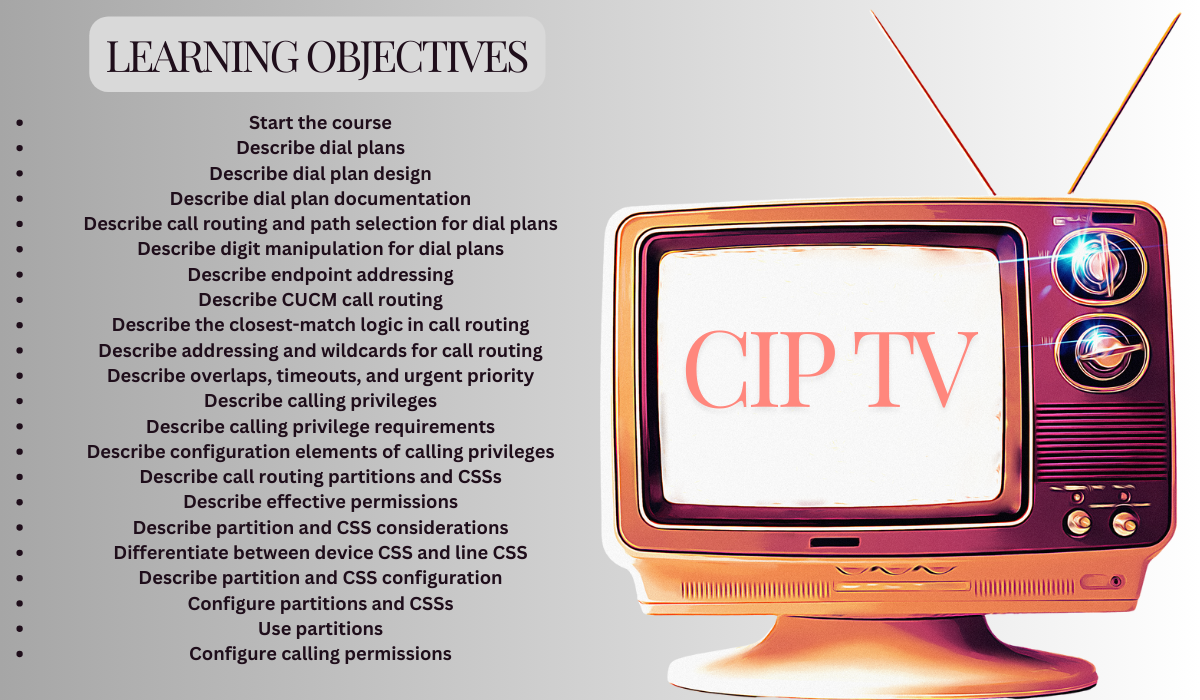In the present quick-moving computerized world, consistent correspondence is critical for any business to flourish. The Cisco Unified Communications Manager (CUCM) offers a robust solution for managing voice, video, and data communications across a network. However, the key to unlocking its full potential lies in understanding and implementing effective dial plans. For collaboration, video, IP network, and telephony engineers embarking on this journey, mastering CUCM dial plans is essential. This blog post will guide you CIPTV through the intricacies of dial plan design, configuration, and optimization, equipping you with the skills needed to deploy CUCM effectively.
Learning Objectives
Before we dive into the details, let’s outline what you can expect to learn from this comprehensive guide:
- Understand the significance of dial plans in CUCM deployments.
- Explore the design, documentation, and implementation of dial plans.
- Delve into call routing, path selection, and digit manipulation.
- Gain insights into endpoint addressing and CUCM call routing.
- Discover best practices for configuring calling privileges and effective permissions.
Start the Course
When starting your learning path, it’s important to set clear objectives. The course focuses on equipping you with the core knowledge required to deploy CUCM in a single site. By the end of this course, you’ll have a solid foundation in Cisco IP Telephony and Video solutions, positioning you for success in the CIPTV1 CCNP Collaboration certification exam.
Key Components of the Course:
- Comprehensive Curriculum: Gain in-depth understanding of dial plans, call routing, and calling privileges.
- Hands-On Training: Practical exercises and real-world scenarios to enhance learning.
- Certification Preparation: Official training for the Implementing Cisco IP Telephony & Video, Part 1 v1.0 (CIPTV1) certification exam.
Describe Dial Plans
A dial plan is the backbone of any Cisco Unified Collaboration deployment. But what exactly is a dial plan? In essence, it defines the rules and patterns that govern how users reach their desired destinations across the communication network.
Elements of a Dial Plan:
- Endpoint Addressing: Assign unique identifiers to devices for seamless communication.
- Call Routing: Determine the best path for calls to reach their intended recipients.
- Calling Privileges: Control who can call whom and define access levels.
- Call Coverage: Ensure calls are handled efficiently, even during peak times.
Describe Dial Plan Design
Designing a dial plan requires a strategic approach to ensure optimal performance and user experience. Here are some key considerations when crafting a dial plan:
- Understand Business Needs: Align the dial plan with organizational goals and user requirements.
- Define Numbering Schemes: Create a logical structure for numbers to facilitate easy call routing.
- Plan for Growth: Design a scalable dial plan that accommodates future expansion.
Best Practices for Dial Plan Design:
- Use standard numbering formats to ensure consistency.
- Implement redundancy and failover mechanisms for reliability.
- Regularly review and update the dial plan to reflect changes in the organization.
Describe Dial Plan Documentation
Documentation is a critical aspect of dial plan management. It serves as a reference for administrators and helps troubleshoot issues effectively.
Key Components of Dial Plan Documentation:
- Numbering Schemes: Detailed descriptions of number formats and assignments.
- Call Routing Policies: Instructions on how calls are routed within the network.
- Access Control Lists: Specifications for calling privileges and permissions.
By maintaining comprehensive documentation, you ensure smooth operations and facilitate easy updates to the system.
Portray Call Directing and Way Determination for Dial Plans
Effective call routing is essential for minimizing latency and ensuring calls reach their destinations promptly. Path selection involves evaluating various routes and determining the optimal one.
Factors Influencing Path Selection:
- Network Topology: Understanding the network layout aids in efficient routing.
- Traffic Load: Balancing call traffic to prevent congestion and maintain quality.
- Redundancy: Implementing alternate routes for failover and reliability.
Describe Digit Manipulation for Dial Plans
Digit manipulation involves modifying dialed numbers to match the required format for call processing. This process is crucial for ensuring seamless communication between different systems.
Common Digit Manipulation Techniques:
- Translation Patterns: Modify numbers based on predefined rules.
- Prefix and Suffix Addition: Add or remove digits to align with destination requirements.
- Normalization: Standardize numbers for consistent handling across the network.
Describe Endpoint Addressing
Endpoint addressing assigns unique identifiers to devices within the network, enabling seamless communication. Proper endpoint addressing is vital for efficient call routing and management.
Types of Endpoint Addressing:
- E.164 Numbers: International numbering format for global compatibility.
- IP Addresses: Unique identifiers for devices in an IP-based network.
- MAC Addresses: Hardware-based identifiers for network interfaces.
By accurately configuring endpoint addresses, you ensure smooth and reliable communication across the organization.
Describe CUCM Call Routing
CUCM call routing determines the path a call takes from the originating device to its destination. Understanding this process is crucial for optimizing call handling and minimizing latency.
Key Components of CUCM Call Routing:
- Route Patterns: Define patterns for matching dialed numbers.
- Route Lists and Groups: Organize routes into logical groups for efficient management.
- Device Pools: Group devices with similar settings for streamlined administration.
Describe the Closest-Match Logic in Call Routing
The closest-match logic is a fundamental concept in call routing. It ensures that the most specific route pattern is selected, minimizing call setup time and enhancing user experience.
How Closest-Match Logic Works:
- Pattern Matching: CUCM evaluates dialed numbers against available patterns.
- Priority Levels: Assigns priority to specific patterns for efficient routing.
- Fallback Options: Provides alternate routes in case the closest match fails.
Describe Addressing and Wildcards for Call Routing
Addressing and wildcards play a significant role in call routing flexibility. They enable administrators to define patterns that cater to various scenarios.
Common Wildcards in Call Routing:
- X: Matches any single digit (0-9).
- . (Dot): Matches one or more characters.
- ! (Exclamation): Matches one or more digits of variable length.
By utilizing addressing and wildcards effectively, you can handle diverse dialing scenarios with ease.
Describe Overlaps, Timeouts, and Urgent Priority
Handling overlaps, timeouts, and urgent priority settings is crucial for maintaining smooth call flow in complex networks.
Strategies to Manage Overlaps and Timeouts:
- Overlap Handling: Configure CUCM to manage overlapping dial patterns.
- Timeouts: Set appropriate timeouts for call processing to prevent delays.
- Urgent Priority: Prioritize critical calls to ensure timely delivery.
Describe Calling Privileges
Calling privileges determine who can call whom within the network. Proper configuration ensures secure and efficient communication.
Key Considerations for Calling Privileges:
- Access Control Levels: Define permission levels for different user groups.
- Time-Based Restrictions: Implement restrictions based on time of day.
- Emergency Call Handling: Ensure emergency calls are always prioritized.
Describe Calling Privilege Requirements
Understanding the requirements for calling privileges is essential for setting up a secure and efficient communication system.
Essential Components of Calling Privilege Requirements:
- User Roles: Define roles and permissions based on job functions.
- Access Policies: Establish policies to control call access and restrictions.
- Compliance: Ensure adherence to industry regulations and standards.
Describe Configuration Elements of Calling Privileges
Configuring calling privileges involves setting up the necessary components to enforce access control effectively.
Steps to Configure Calling Privileges:
- Define User Roles: Create roles with specific permissions for call handling.
- Assign Permissions: Allocate permissions based on organizational needs.
- Test and Validate: Conduct thorough testing to ensure configurations work as intended.
Describe Call Routing Partitions and CSSs
Call routing partitions and CSSs (Calling Search Spaces) are integral to efficient call management.
Key Components of Call Routing Partitions and CSSs:
- Partitions: Group dialable numbers based on access requirements.
- CSSs: Define which partitions a device can access.
- Access Control: Implement access control using partitions and CSSs.
Describe Effective Permissions
Effective permissions determine what actions a user can perform within the communication network. The proper configuration ensures secure and compliant operations.
Factors Influencing Effective Permissions:
- User Roles: Assign permissions based on user roles and responsibilities.
- Access Levels: Set access levels to control resource availability.
- Least Privilege Principle: Grant only necessary permissions to users.
Describe Partition and CSS Considerations
When setting up partitions and CSSs, several factors must be considered to ensure optimal call management.
Best Practices for Partition and CSS Configuration:
- Simplify Configurations: Keep configurations straightforward for easier management.
- Regular Audits: Conduct audits to verify configurations align with business needs.
- Scalability: Design configurations that accommodate future growth.
Differentiate Between Device CSS and Line CSS
Understanding the difference between device CSS and line CSS is crucial for effective call management.
Key Differences Between Device CSS and Line CSS:
- Device CSS: Applied globally to the device for overall call handling.
- Line CSS: Applied to individual lines for specific call routing.
- Priority: Line CSS takes precedence over device CSS when conflicts arise.
Describe Partition and CSS Configuration
Configuring partitions and CSSs involves setting up access controls and routing rules for efficient call management.
Steps for Partition and CSS Configuration:
- Define Partitions: Group numbers based on access requirements.
- Create CSSs: Set up CSSs to control access to partitions.
- Test and Validate: Ensure configurations function as intended through testing.
Configure Partitions and CSSs
Configuring partitions and CSSs is a critical step in ensuring smooth call management within CUCM.
Procedure for Partition and CSS Configuration:
- Identify Access Needs: Determine access requirements for different user groups.
- Set Up Partitions: Create partitions to group dialable numbers.
- Assign CSSs: Allocate CSSs to devices and lines for access control.
Use Partitions
Partitions are essential for organizing dialable numbers and controlling access within the communication network.
Importance of Using Partitions:
- Access Control: Restrict access to specific numbers based on partitions.
- Efficient Routing: Improve call routing by grouping numbers logically.
- Security: Enhance security by limiting access to sensitive numbers.
Configure Calling Permissions
Configuring calling permissions ensures secure and controlled communication within the organization.
Steps for Configuring Calling Permissions:
- Define Access Levels: Create access levels for different user roles.
- Set Permissions: Allocate permissions based on access levels.
- Test Configurations: Validate configurations through thorough testing.
Conclusion CIPTV
Mastering CUCM dial plans is crucial for creating a seamless communication experience within enterprise networks. By understanding the intricacies of dial plan design, call routing, and calling privileges, you can optimize communication processes, improve efficiency, and enhance collaboration. Whether you’re pursuing the CIPTV1 CCNP Collaboration certification or seeking to enhance your organization’s communication infrastructure, this knowledge is invaluable. Take the next step by exploring further resources, engaging with Cisco’s training programs, and applying these insights to your deployment initiatives.

